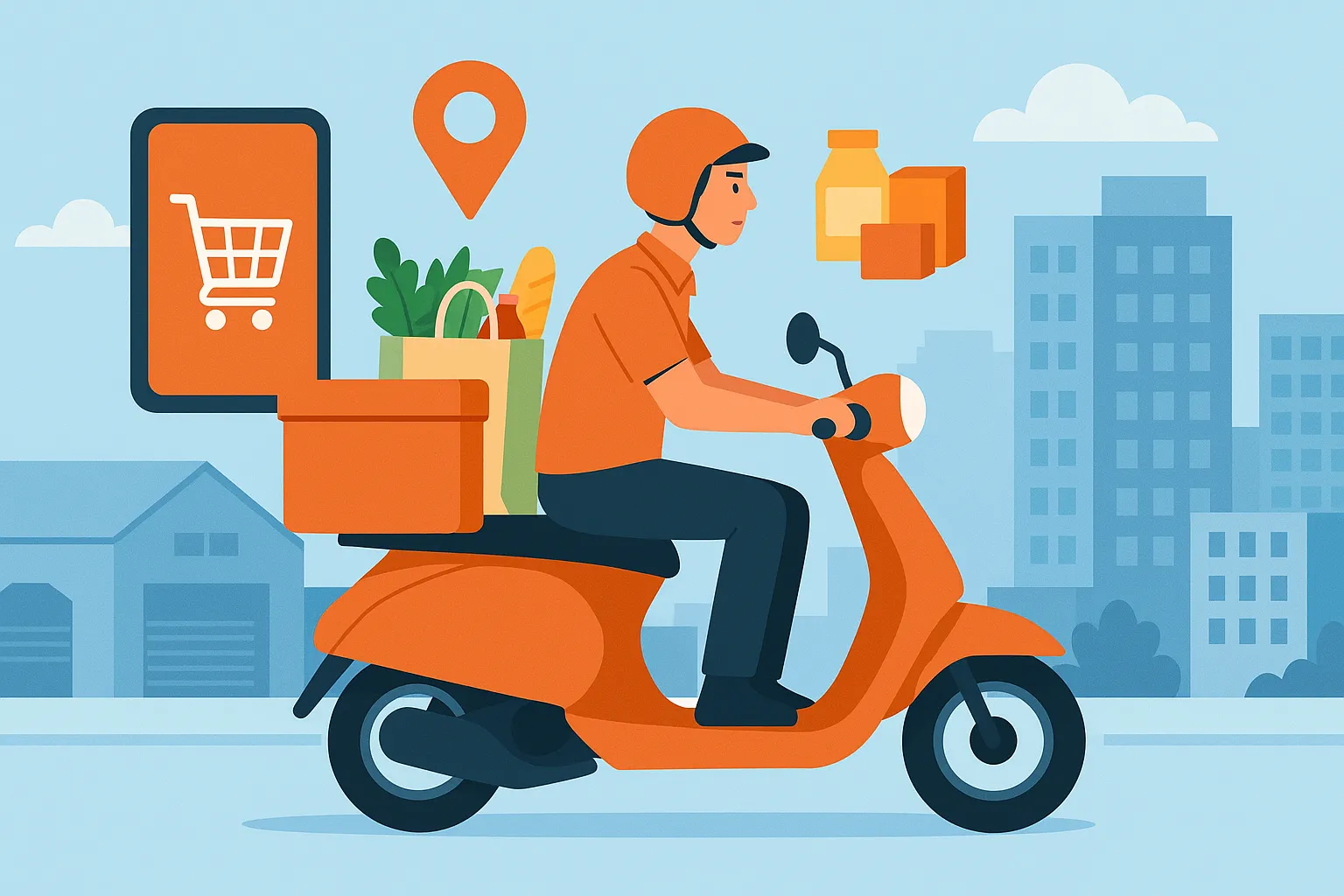Grofers is one of India’s most recognized online grocery delivery platforms. Launched to simplify how households shop for daily essentials, Grofers has disrupted traditional retail with its quick commerce approach and hyperlocal delivery network.
Understanding the business model of Grofers is essential for any entrepreneur interested in launching a similar app. From innovative revenue streams to scalable operations, Grofers demonstrates how technology, logistics, and customer experience come together to build a billion-dollar grocery platform. In this article, you’ll discover exactly how Grofers works, who it serves, how it generates revenue, and what you can learn if you plan to build your own grocery delivery app.
What is Grofers & How It Works
Grofers is an online grocery delivery app that connects customers with nearby warehouses and partner stores to deliver groceries and daily essentials quickly and affordably.
The Problem It Solves:
Traditionally, grocery shopping in India has involved long queues, limited product variety, and unpredictable delivery timelines. Grofers solves these pain points by:
- Offering a digital catalog of thousands of products
- Allowing customers to order from their phone
- Ensuring fast, reliable doorstep delivery
How Grofers Operates:
Grofers primarily uses a warehouse-driven inventory model combined with a robust last-mile logistics network. Here’s how it works step by step:
- Sourcing: Grofers procures products in bulk directly from manufacturers, distributors, and large suppliers.
- Warehousing: Inventory is stored in regional fulfillment centers strategically located across cities.
- Ordering: Customers place orders via the Grofers mobile app or website.
- Picking & Packing: Warehouse staff pick, pack, and label the items.
- Delivery: Last-mile delivery agents collect and deliver orders to the customer’s doorstep within a chosen time slot.
In some cities, Grofers also partners with local stores to expand product availability and enable faster delivery.
Who Uses Grofers?
- Busy working professionals who don’t have time for in-store shopping
- Families looking for cost savings through bulk purchases
- Millennials who prefer digital-first convenience
- Apartment communities relying on scheduled deliveries
This combination of centralized inventory and local delivery has made Grofers one of India’s most efficient grocery apps.
Read More : What is Grofers App and How Does It Work?
Target Audience
Grofers has designed its platform to serve a diverse set of customer segments across India. Here are the main groups who rely on the app:
- Urban Millennials and Young Professionals:
Tech-savvy customers in metro cities who prefer ordering groceries via smartphone instead of visiting crowded markets. - Working Families:
Dual-income households that need bulk groceries delivered on a schedule to save time and hassle. - Senior Citizens:
Elderly customers who appreciate home delivery of heavy or bulky items without the need to carry them from stores. - Apartment and Gated Community Residents:
Groups of neighbors who collectively order weekly essentials and benefit from delivery slots and discounts. - Value-Conscious Shoppers:
Price-sensitive customers who prefer Grofers’ lower prices, bundled offers, and loyalty programs over traditional retail markups.
By understanding these audiences, Grofers has been able to tailor marketing campaigns, delivery options, and pricing strategies that drive repeat business and customer loyalty.
Features that Support the Business Model
Grofers has developed a range of features that not only improve customer experience but also directly contribute to revenue generation. Here are the core features that power its business model:
- Scheduled Delivery Slots:
Customers can choose precise delivery times, allowing Grofers to optimize routes and improve operational efficiency. - Bulk Buying & Discounts:
Special pricing on larger quantities encourages customers to spend more per order, increasing average order value. - Subscription Plans:
Membership programs like Grofers Smart Bachat Club offer exclusive discounts and free delivery, creating predictable recurring revenue. - Personalized Recommendations:
AI-driven suggestions based on past purchases boost cross-selling and upselling opportunities. - Digital Payments Integration:
Seamless integration with wallets and payment gateways speeds up checkout and reduces cash handling costs. - Real-Time Order Tracking:
Customers can see their order status live, enhancing trust and reducing support queries. - Loyalty and Referral Programs:
Rewards and incentives encourage word-of-mouth growth and increase customer retention.
These features work together to lower operational costs, maximize customer lifetime value, and drive repeat purchases—all essential pillars of Grofers’ success.
Read More : Grofers App Features Every Startup Should Know
Revenue Streams of Grofers
Grofers generates revenue through multiple channels that create a balanced and sustainable income model. Below is a table summarizing each stream:
| Revenue Stream | How It Works |
| Product Markup | Grofers buys in bulk at lower prices and sells at a margin over procurement cost. |
| Subscription Fees | Customers pay for membership plans like Smart Bachat Club for discounts & perks. |
| Delivery Charges | Standard or express delivery fees for orders below minimum value. |
| Advertising Fees | Brands pay to promote their products in the app and get priority placements. |
| Private Label Sales | Grofers sells its own branded products with higher profit margins. |
| Commission on Partner Stores | When partnering stores fulfill orders, Grofers earns a commission per sale. |
Quick Explanations:
- Product Markup:
The primary driver of revenue. By managing supply chain and warehousing, Grofers keeps margins healthy. - Subscription Fees:
Paid plans create predictable recurring income and lock in customer loyalty. - Delivery Charges:
While many orders qualify for free delivery, smaller carts generate extra income through fees. - Advertising Fees:
FMCG brands and local suppliers pay for in-app promotions, banners, and sponsored listings. - Private Label Sales:
Grofers’ own brands (e.g., Happy Home) yield higher profitability compared to third-party products. - Commissions:
In hybrid models, Grofers earns a cut of each order fulfilled by partnered local stores.
This diversified model allows Grofers to scale while reducing dependency on any single revenue stream.
Read more : Revenue Model of Grofers: How the Instant Grocery App Makes Money
Cost Structure
Running a grocery delivery platform like Grofers involves significant operational and marketing expenses. Here are the main cost components:
- Warehousing & Inventory Management:
Renting and operating fulfillment centers, cold storage facilities, and stock handling systems. - Logistics & Last-Mile Delivery:
Fleet maintenance, fuel, driver salaries, route optimization software, and packaging materials. - Technology Development:
Building and maintaining the mobile app, website, backend systems, and data analytics tools. - Marketing & Customer Acquisition:
Digital advertising, referral incentives, loyalty rewards, and promotional campaigns to drive new users. - Payment Processing Fees:
Costs associated with integrating wallets, credit card gateways, and refund handling. - Workforce Salaries:
Salaries for warehouse staff, delivery personnel, customer support teams, and management. - Vendor & Supplier Payments:
Payments to product suppliers, brands, and partner stores.
Controlling these costs while maintaining service quality is key to achieving profitability, especially in high-competition markets.
2024–2025 Innovations or Updates
Grofers has evolved rapidly to stay ahead in the competitive quick commerce landscape. Here are some recent innovations and strategic changes that impact its business model:
- Rebranding to Blinkit:
Grofers officially rebranded as Blinkit to emphasize ultra-fast 10–20 minute deliveries. This shift positions the company squarely in the quick commerce segment. - Express Delivery Focus:
The platform has expanded micro-fulfillment centers in metro cities to meet the rising demand for near-instant grocery delivery. - Dynamic Pricing & Surge Delivery Fees:
Introduction of variable pricing during peak hours or high-demand periods to balance logistics costs and delivery capacity. - Enhanced Private Label Portfolio:
Broader selection of own-brand products with better margins, catering to health, organic, and budget-conscious categories. - Integration with Zomato Ecosystem:
After Zomato’s investment, Grofers/Blinkit began experimenting with cross-platform promotions and bundled offers with restaurant deliveries. - AI-Driven Recommendations:
More sophisticated personalization algorithms to improve product discovery and increase basket size.
These updates demonstrate Grofers’ commitment to evolving the business model and capitalizing on India’s fast-growing online grocery market.
Takeaways for Startup Founders
Building a grocery delivery platform like Grofers requires more than just a mobile app—it’s about creating a seamless ecosystem that balances convenience, affordability, and operational efficiency. Here are some insights if you’re planning to launch your own grocery delivery venture:
- Inventory Control is Critical:
A warehouse-driven model helps you maintain pricing power and delivery speed. Consider hybrid models if you need flexibility early on. - Subscriptions Drive Loyalty:
Paid membership plans can lock in users, boost repeat orders, and create predictable cash flow. - Last-Mile Delivery Needs Investment:
Efficient logistics, route optimization, and a reliable delivery workforce are essential to delight customers and control costs. - Private Labels Increase Margins:
Introducing your own branded products can significantly improve profitability over time. - Fast Delivery is the Future:
Consumers increasingly expect 10–30 minute delivery windows—plan for micro-warehousing and geo-targeted inventory.
Read more : Reasons startup choose our Grofers clone over custom development
Why Build Your App with Miracuves?
At Miracuves, we specialize in ready-made Grofers apps that help you launch faster and smarter. You’ll get:
- Pre-built features like real-time tracking, subscriptions, and inventory management
- Scalable architecture ready for hyperlocal delivery
- Expert guidance to customize the platform for your target market
By working with Miracuves, you can avoid costly trial and error and focus on growing your grocery delivery business confidently.
growing your grocery delivery business confidently.
Read more : How to Build an App Like Grofers: Full-Stack Developer Guide for 2025
Conclusion :
The business model of Grofers shows how technology, smart logistics, and customer-centric features can transform a traditional industry. From warehouse-driven operations to subscription plans and express delivery, Grofers has set a high bar for online grocery platforms in India.
If you’re an entrepreneur inspired to build your own grocery delivery app, now is the time to act. With proven revenue strategies and a fast-growing market, you can capture a loyal customer base and build a sustainable business.
Ready to launch your own Grofers-style grocery delivery app? Explore our Grofers Solution or request a free demo, and let Miracuves help you build the next big success story in online grocery delivery.
FAQs
1. How does Grofers make money?
Grofers earns revenue through product markups, delivery fees, subscription plans like Smart Bachat Club, advertising from brands, private label sales, and commissions on partner store orders.
2. What makes Grofers’ business model successful?
Its combination of bulk procurement, warehouse control, fast last-mile delivery, and innovative pricing strategies has helped Grofers keep costs low and maintain strong customer loyalty.
3. Is Grofers the same as Blinkit?
Yes. In 2022, Grofers rebranded itself as Blinkit to focus on ultra-fast grocery delivery in 10–20 minutes.
4. What technology stack is needed to build a Grofers-like app?
You’ll need a robust backend, a real-time order management system, delivery routing algorithms, mobile apps for customers and drivers, and scalable cloud infrastructure. Miracuves offers pre-built solutions that cover all these areas.
5. How can I get started with my own grocery delivery app?
You can start by exploring ready-made app clones, defining your target audience and delivery areas, and partnering with suppliers. With Miracuves, you can launch quickly with all essential features built in.
Related Articles :
- How to Build an App Like Blinkit: A Developer’s Guide to Fast-Growth Grocery Delivery Apps
- How to Build a Grocery Delivery App Like FreshDirect: Features, Tech, and Cost
- Create a Grocery Delivery App Like BigBasket: Features, Cost, and Technology
- The Best Grocery Delivery Services of 2025: Top Picks for Convenience








